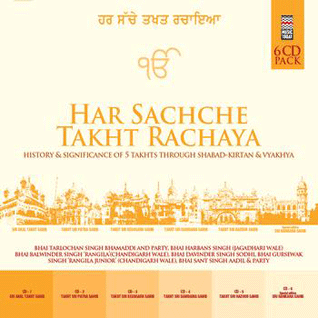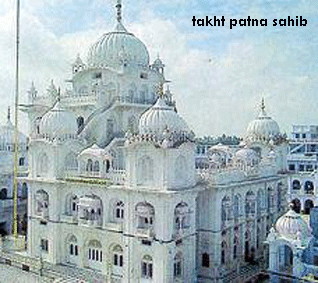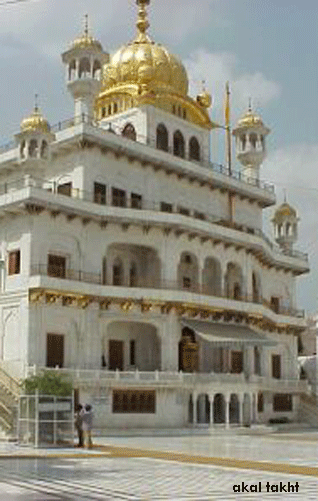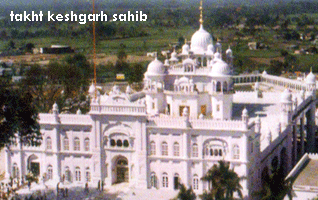Music
Singing Songs of The Five Takhts
by SHAILAJA TRIPATHI
Music and faith have always been known to share a deep relationship with each other. The subcontinent's tradition boasts a vast repertoire that comprises songs meant to praise, invoke, please and plead with a variety of deities on ceremonies and special occasions.
But with the emphasis Sikhism lays on kirtan in honour of One God, the Lord of all, music is a uniquely integral part of Sikhism.
The Fifth Sikh Guru, Arjan, first compiled the Adi Granth - which later, in its completed form, became Guru Granth, the expansive living Word of the religion. In doing so, Guru Arjan set the various shabads or hymns to prescribed raags. Known as bani, the Guru Granth consists of the compositions of the Gurus and a number of bhagats belonging to different faiths, but whose verses comformed with Sikhi.
"Har Sachche Takht Rachaaya", a six CD set narrating the history and significance of the five Takhts of Sikhism, launched by Music Today, is in accordance with the belief that music helps connect with the Almighty. It is in the genre of shabad-kirtan, though the listeners will find one aarti, a few vaars sung by the Dhadis (ballad singers) or a pauri, which dominates the album.
What renders novelty to the exercise is that the compositions have been grouped together under various Takhts, describing and presenting their historical development and relevance.
Takhts refer to the seat (thrones) of authority which is instituted in five gurdwaras - Akal Takht Sahib (Amritsar), Harmandar Sahib (Patna), Keshgarh Sahib (Anandpur), Damdama Sahib (Sabo ki Talwandi, Bhatinda), Hazoor Sahib (Nanded) - where important decisions concerning the religious and social life of the Sikh community are taken.
Differentiating between the strong forceful renditions of Akal Takht Sahib and the soft compositions of Takht Patna Sahib, renowned Raagi, Bhai Balwinder Singh ‘Rangila' explains: "The time period from Guru Nanak extending up to Guru Arjan was largely peaceful, and the shabads like ‘Kirpa Kar Shyam' and ‘Jin Prem Kiyo' came into being during this time.
"It was during the reign of Jahangir that things began turning ugly. Guru Arjan was tortured under his orders for refusing to embrace Islam. Following his father's martyrdom, his son and the Sixth Guru, Hargobind, began forming an army to fight against injustice and set up the Akal Takht."
Accounts of Chivalry
Dhaadi parampara, the practice of singing the accounts of chivalry of the brave heroes of the past to fill the warriors with vigour and confidence, is said to have originated during this time. "Which is why the music in this CD (Mahima Sri Akal Takht Sahib) is soaked in veer ras. The folkish tunes, high pitch, use of dhaadh marks this presentation of the Dhaadis like Bhai Tarlochan Singh Bhammadi, Amarjit Singh Sandhu, C.S. Jalalabadi," he adds.
A famous 17th Century vaar, "Pag teri ke Jahangir di" (praising Guru Hargobind), sung by two ballad singers Natha Mal and Abdullah, has also made it to this section.
Since at Keshgarh Sahib was established the crucial Khalsa Panth by Guru Gobind Singh, the compositions that have been incorporated elaborate on the central idea of the Khalsa, which literally means ‘pure ones' - for instance "Khalsa mero roop hai khaas, khalse mein ho karo nivaas", from the compositions of Guru Gobind Singh.
"A total of about 31 raags have been used in the Guru Granth Sahib, but we have tried to keep the rendition simple so as to make it accessible to a common listener. Since Guru Granth Sahib recommends the use of tanti saaz or stringed instruments, the sitar has been used abundantly," clarifies Bhai Balwinder Singh ji, who has sung in the fourth CD of Damdama Sahib.
Guru Gobind Singh's last sermon which is now part of the daily routine at gurudwaras after ardaas: "Aagya bhai Akal ki tabhi chalayo panth, sab Sikhan ko hukum hai Guru Manyo Granth", features in the Takht Hazoor Sahib CD. Another distinctive element of this particular CD is the aarti, "Gagan mein thaal".
Guru Nanak sang it at Jaganaath Puri. When the king chided him for not doing aarti at the temple, it was Nanak's reply: he declared that the true aarti is with the entire universe - the sun, moon, stars, trees - which are forever in His worship!
[Edited from the original which first appeared in The Hindu newspaper.]
July 29, 2010






